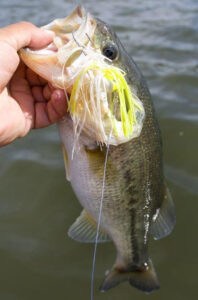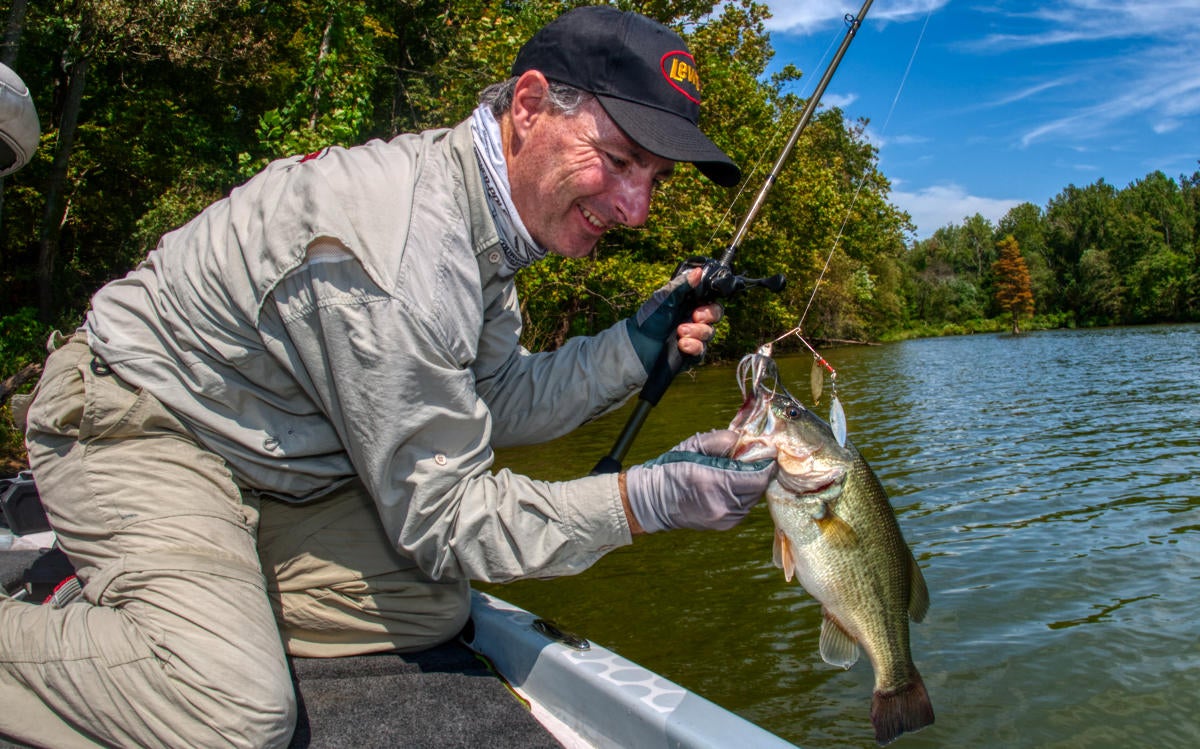The nights are cooling and the light period is shortening everyday as we head into the fall. For bass fishing that means those bass that have been way away from the bank and out in the middle of the lake are going to start using the banks, points and channel swings as highways to get back to the backs of the creeks to stuff as many “nacho-sized” shad into their gullet before it gets too cold to chase.
The phrase feast or famine comes into discussions a lot this time of year. The bass are feasting on an abundance of forage in most fisheries and fishing can be a famine for those folks that keep to the standard routines of just slowly beating the banks. It takes a little different mentality in the fall than it did through the summer.
While the summer months are often dictated by fishing areas and grinding with bottom baits in areas where bass like to group up and feed, fall is more about roaming and foraging for the bass. This is why fishing can seem so tough. The bass are constantly on the move chasing food, and there is an over abundance of food.
Burning the banks
Strike King pro Mark Menendez talked about fall fishing as one of his favorite times for bass fishing of the whole year.
“One of the things I love to do is burn a spinnerbait in the fall,” Menendez said. “The first time I qualified for the Bassmaster Classic, more than half my fish that year were caught burning a spinnerbait. It was a solid white spinnerbait with white blades. And now the temperature is getting right for that technique to be dominant again.”
Menendez fished some tournaments up north and learned how effective those burned spinnerbaits with painted blades can be for big smallmouths. Since then he’s also seen how effective it is on largemouth bass and spotted bass as well.
“It’s the best bite in bass fishing,” Menendez said.
This is one of those techniques where your gear is as critical as where you fish. If you fish too slow a reel ratio or heavy cumbersome rod and too light of line, you’ll be too worn out a few hours in to continue fishing this way for the remainder of the day. Menendez opts for 20-pound monofilament line, a Lew’s Tournament Pro 7:1 baitcasting reel and a 7-foot, 3-inch Power Tackle glass rod with the palmable grip. The grip on that rod relieves a lot of his fatigue and the glass rod and mono absorb the shock of the savage strikes.
His spinnerbaits of choice are either a ½-ounce Strike King Burner spinnerbait in a shad pattern or a new Tour Grade Strike King Spinnerbait with painted blades. Willow blades are a must for this technique. And in Menendez’s experience, a free swinging trailer hook can be the difference between just strikes and landing bass at high speeds. In fact on days when the bass just nip at the spinnerbait, Menendez takes 2 inches of braid and attaches a treble hook to the hook of the spinnerbait. That stinger gets those slashers.
Once he’s got the right tackle, he starts targeting points. We’re not just talking about points of land in the water. He’s thinking of ambush points. He pulls into an area and looks for places where you can burn the spinnerbait over or by and a fish can run out and grab it. It could be a rock outcropping on an otherwise gravel bank. It could be just points in the grass. It could be a pea gravel point that extends way out into the lake breaking up an otherwise deep area.
Bass suspend and watch for bait in these types of places and then pounce on it when it swims by.
“It’s a knee-jerk reaction most of the time,” Menendez said. “They see something coming from a long way off at a high rate of speed and then all the sudden it’s going away from them and they get on their horse and run it down. That’s what’s so great about those big smallmouths. They are built to run down baits moving this fast.”
When a big smallmouth hits a burning spinnerbait for the first time, you’ll be changed forever in bass fishing. It’s the stuff of which bass fishing dreams of heaven are made. The strikes are so violent because they have to swim so fast and take the bait down in one move. It’s definitely not for the faint of heart.
The painted blades can make the bait look like multiple baits or a bigger profile in the water. But there are still a lot of days where the conditions aren’t perfect for it. And some reservoirs are better than others for this technique. Menendez has learned from a lot of trial and error on fisheries like Minnetonka, the Coosa River, Lake Erie, Kentucky Lake, Lake Champlain and others around the country that this technique works. And certain conditions make it optimal.
He’s found for some reason on the brighter days he catches a lot of largemouths and when it’s real nasty and ugly out with dark skies, wind and weather, he catches more smallmouths and spotted bass with the technique.
“Wind is your friend in the fall,” Menendez said. “But I’ve caught them on calm, slick, bright days as well. I had one of my best days ever catching spots burning a spinnerbait on the Coosa River many years ago. I had a 5 1/2-pound spot and a 4 1/2-pound spot in that limit that went 21 pounds all caught by burning a spinnerbait.”

Stop burning and start churning
When he’s not burning in the fall, he’s churning with a Strike King Pure Poison vibrating bladed jig. He likes the 1/4 and 3/8-ounce sizes because the Pure Poisons tend to run a little heavier than their listed weights. The 1/4 ounce is one of his favorites for what he calls the staple pattern in the fall, schooling fish.
When the bass group up to herd shad in the backs of pockets a lot of guys are firing topwaters and rattling lipless baits like a Red Eye Shad around on those flats, but Menendez has found that the small Pure Poison can really attract the right bass. He’ll catch them casting and winding with a fairly straight retrieve.
After the fish stop biting on a steady retrieve, he’ll start incorporating a lift and drop action using his rod to fish it more, and he’s often caught bigger fish doing this. It can be a great follow up bait to places where other anglers have been throwing lipless baits.
When the fish get especially moody he modifies his vibrating jig by taking the skirt off and adding a minnow type body to it. His favorite is a Strike King Glass Minnow in a baitfish color. It gives the bass a better profile and you can mimic their forage a lot better when they get especially finicky.
Most folks think that nasty and windy is better for a vibrating jig bite, but Menendez prefers the slick calm days because the fish have a tendency to school a little better in the backs of pockets and in small bays. And covering water is paramount. You have to fish a lot of bays and pockets before you find the right fish.
For churning with a Pure Poison he likes a 6.4:1 Lew’s reel, 17 pound fluorocarbon and a 6-foot, 10-inch graphite Power Tackle rod. He’ll upsize to braid on his line if he’s fishing around a lot of vegetation.
For these patterns he’s found that rock can play a big role. Not only as an ambush point, but the harder bottoms seem to keep the right fish around in the fall. Even if he’s on a grassy fishery, he’s looking for those rock hard bottoms, especially the ones where the rocks seem to break up and scatter the grass a little more. It makes for some great ambush action.
“I just love the strikes in the fall with these techniques, especially burning a spinnerbait,” Menendez said. “It looks like someone jumped off a diving board right onto your bait. If you’re not completely sore in your hands and arms at the end of the day, then you haven’t been churning and burning with some fall bass fishing.”











